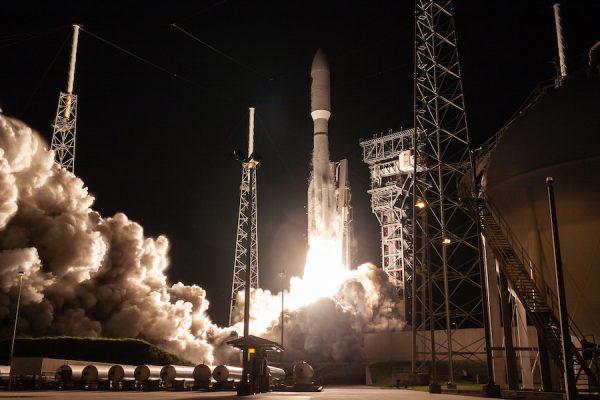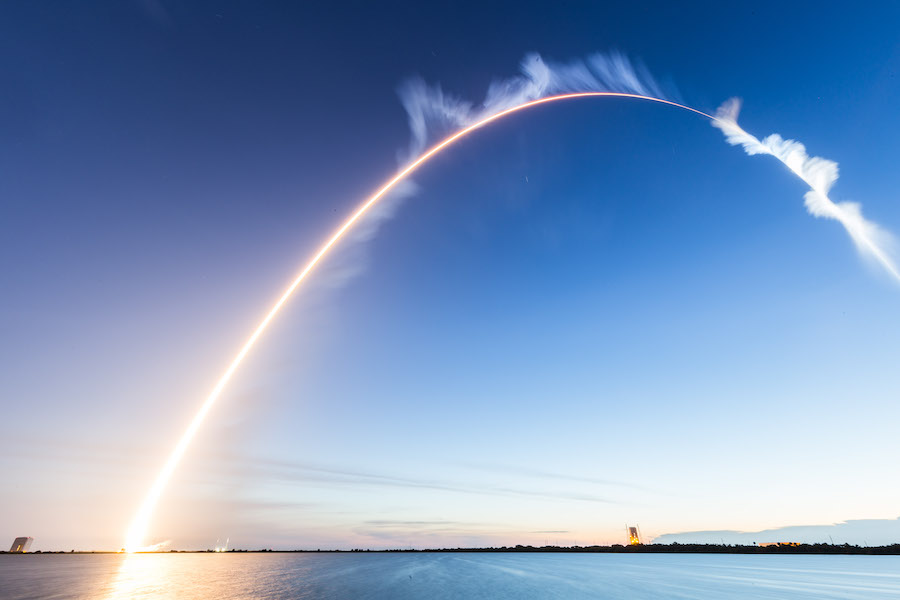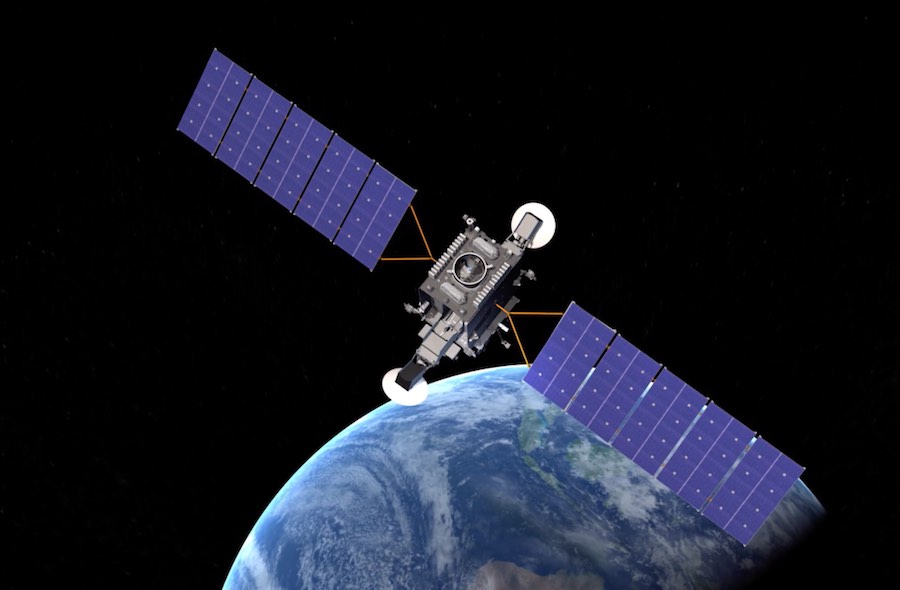Atlas 5 launch adds to US military’s secure communications satellite network – Spaceflight Now

A United Launch Alliance Atlas 5 rocket fired into space Thursday from Cape Canaveral with a $1.1 billion U.S. Air Force communications satellite, delivering fresh capacity for the military’s voice, video and data relay networks.
The 197-foot-tall (60-meter) Atlas 5 launcher lifted off from pad 41 at Cape Canaveral Air Force Station at 6:13 a.m. EDT (1013 GMT) Thursday. Powered by a kerosene-fueled Russian-built RD-180 main engine and five strap-on solid rocket boosters, the Atlas 5 flashed to life and thundered into the morning twilight over Florida’s Space Coast.
The main engine and solid rocket boosters combined to produce some 2.6 million pounds of thrust to push the Atlas 5 into the sky with the Air Force’s fifth Advanced Extremely High Frequency communications satellite to provide secure, protected links between military commanders and government leaders.
ULA’s launch team kept the Atlas 5 launcher on the ground for 29 extra minutes Thursday as engineers evaluated several technical issues involving the rocket’s GPS tracking system, the first stage steering system, and a concern related to data patching.
The launch team resolved all the technical issues and gave approval to proceed with the final four minutes of the countdown.
The delay ended up placing the Atlas 5’s launch time at the right moment in the morning twilight to allow the rocket to climb into sunlight high up in the atmosphere around two minutes into the mission. The sunlight illuminated the Atlas 5’s exhaust plume and ice particles in the rarefied atmosphere, creating a prominent teardrop-shaped cloud in the sky.
The rocket’s five strap-on boosters and payload fairing also shimmered in the morning sun after their jettison from the launcher. The components’ glinting appearance added to the spectacle as they fell into the Atlantic Ocean.
The Atlas 5’s first stage finished its job around four-and-a-half minutes after liftoff Thursday. The Atlas core booster then fell away from the rocket’s Centaur upper stage, which ignited a hydrogen-fueled Aerojet Rocketdyne RL10C-1 engine three times over five-and-a-half hours to inject the 13,600-pound (6,168-kilogram) Lockheed Martin-built AEHF 5 satellite into an elliptical transfer orbit stretching as far from Earth as 22,000 miles (35,000 kilometers) at its highest point.
ULA and Air Force officials confirmed an on-target deployment of the AEHF 5 spacecraft a few minutes before 12 p.m. EDT (1600 GMT). Ground controllers from the 4th Space Operations Squadron at Schriever Air Force Base in Colorado began communicating with the AEHF 5 satellite as expected, verifying the new relay asset is functioning after launch, Lockheed Martin said in a statement.
Thursday’s mission marked the 80th flight of an Atlas 5 rocket since August 2002, and the first Atlas 5 flight in nearly 10 months.
The Atlas 5’s blastoff at dawn was also the second launch from Cape Canaveral Air Force Station in less than a day-and-half.

A Falcon 9 rocket operated by ULA rival SpaceX took off from pad 40 — about 1.5 miles (2.5 kilometers) south of the Atlas 5 pad — Tuesday at 7:23 p.m. EDT (2323 GMT) with the Israel-owned Amos 17 commercial communications satellite.
Less than 35 hours separated the two launches, the shortest span between two orbital missions at Cape Canaveral since May 1981, according to a launch log tabulated by Jonathan McDowell, an astronomer at the Harvard-Smithsonian Center for Astrophysics who tracks global space activity.
A Delta rocket launched with a GOES weather satellite on May 22, 1981, followed by liftoff of an Atlas-Centaur launcher and an Intelsat communications satellites a little more than 24 hours later.
Several new launch providers plan to start flying rockets from Cape Canaveral in the next few years, including Blue Origin, Firefly Aerospace and Relativity Space. With new entrants to the market joining the Cape Canaveral launch manifest, the Air Force is pushing to streamline and modernize range infrastructure on Florida’s Space Coast to support up to 48 missions per year.
That would be equivalent to an average of about one launch per week, with a few weeks of down time for maintenance on the range. In some cases, the range aims to be ready to accommodate two launches on the same day, officials said.
The Air Force’s 45th Space Wing operates range safety, security and ground infrastructure on the Eastern Range, which supports all launches from Florida’s Space Coast, from pads on NASA and Air Force property.
The AEHF 5 satellite launched Thursday joins four previous AEHF satellites launched in 2010, 2012, 2013 and 2018, all on past Atlas 5 rocket missions.
With four AEHF satellites already in space, the network provides global, secure, jam-resistant communications services between U.S. government leaders and military commanders. The AEHF fleet is a follow-on to the Air Force’s Milstar satellite network.
The addition of a fifth AEHF satellite will add extra capacity and resiliency to the network.
“This fifth satellite adds an additional layer of flexibility for critical strategic and tactical protected communications serving the warfighter,” said Mike Cacheiro, vice president for protected communications at Lockheed Martin. “This added resilience to the existing constellation will help ensure warfighters can connect globally to communicate and transmit data at all times.

“In the weeks ahead, AEHF 5 will move towards its operational orbit, deploy all of its solar arrays and antennas, and turn on its powerful communications payload for a rigorous testing phase prior to hand over to the Air Force,” Cacheiro said in a statement.
Northrop Grumman supplies the communications payload for the AEHF satellites, which are designed to operate for at least 14 years.
Air Force officials anticipate a longer lifetime from AEHF 5, thanks to a high-energy boost from the Centaur upper stage.
For the AEHF 5 mission, ULA added extra hardware and maneuvering fuel to the Centaur stage, enabling the launcher to deliver the AEHF 5 satellite closer to its final geostationary orbit more than 22,000 miles (nearly 36,000 kilometers) above the equator.
“We’re launching with the Centaur geosynchronous orbit kit,” said Col. Shane Clark, AEHF 5 mission director from the Launch Enterprise Systems Directorate at the Air Force’s Space and Missile Systems Center. “The GSO kit enables an orbital insertion much closer to the final orbit than a traditional geosynchronous transfer orbit, maximizing on-orbit capability of the AEHF 5 space vehicle.”
The extra performance provided by the GSO kit allowed the Centaur upper stage to coast an additional two hours before its third firing. The total duration of the AEHF 5 launch sequence lasted more than two hours longer than that of the AEHF 4 mission last year.
Thanks to the mission profile change, the AEHF 5 satellite separated in an orbit with a perigee, or low point, several thousand miles higher than achieved on the AEHF 4 launch last October. That means AEHF 5 will need to consume less of its own finite propellant supply to circularize its orbit, leading to a longer operating lifetime for the mission.
According to an Atlas 5 user’s guide published by ULA, the GSO kit includes additional battery power, a full load of hydrazine to control the upper stage’s orientation in space, and additional shielding over sensitive components, including the Centaur’s hydrogen and oxygen tanks.
The AEHF 5 satellite should arrive in geostationary orbit in October, after three firings by its own engine and around 70 days of continuous thrusting from plasma engines to reshape its orbit over the equator, according to Cacheiro.
What differentiates the AEHF network from other U.S. military communications satellite programs is its ability to withstand threats, such as radiation from a nuclear attack, or jamming.
“If we’re providing communications over a specific theater, whether it’s in Africa, or the Middle East, or the Pacific rim, and we detect a jammer that could knock out your communications … We could have contact with a unit on the ground, and all of a sudden they don’t have communications capability back to their commanders back in the Pentagon, or wherever they might be,” Cacheiro said.
“That puts our warfighter at risk for multiple reasons, so it’s critical that we’re able to block out those jammers,” he said. “They could be as simple as a radio with an antenna from Radio Shack to a complex jamming antenna, which many nations of concern have, so you just have to be able to communicate through any kind of environment.”
A single AEHF satellite has more capacity than the entire five-satellite Milstar constellation, which launched in the 1990s and 2000s.
“Individual data rates increase five-fold compared to Milstar, permitting transmission of tactical military communications, such as real-time video, battlefield maps and targeting data,” Cacheiro said. “AEHF affords national leaders anti-jam, always-on connectivity during all levels of conflict and enables both strategic and tactical users to communicate globally across a high-speed network that delivers protected communications in any environment.”
The AEHF 5 satellite is valued at $1.1 billion, excluding launch and operating costs, according to Don Ruffin, chief of the strategic SATCOM division at the Air Force’s Space and Missile Systems Center.
Adding the cost of the Atlas 5 launch pushes the AEHF 5 mission cost to more than $1.2 billion.
A sixth AEHF satellite is scheduled to launch on an Atlas 5 rocket in March 2020, according to Air Force officials.
Armed forces from Canada, the Netherlands and the United Kingdom have access to the AEHF network through international agreements with the U.S. government.
Thursday’s launch also delivered a suitcase-sized 12U CubeSat into orbit. The U.S. Air Force’s TDO smallsat deployed from a carrier on the aft bulkhead of the Centaur upper stage after the RL10 engine’s second burn, releasing into an elliptical geostationary transfer orbit.
Col. Clark, the AEHF 5 mission director, said the TDO spacecraft is “testing orbital debris tracking technologies.”
The launch of the AEHF 5 mission was delayed from late June, first to allow ULA teams times to replace a failed battery on the Atlas 5 rocket, then to investigate the failure of a component at a supplier that also delayed the next flight of ULA’s Delta 4 rocket.
Asked for details multiple times, ULA officials declined to identify the component, other than to say the part flies on the upper stages of the Atlas 5 and Delta 4 rockets. A spokesperson for Aerojet Rocketdyne, builder of the RL10 upper stage engine on both rockets, said the component of concern was not on the engine itself.
“During one of our final acceptance tests at a supplier, we had a component failure,” said Gary Wentz, ULA’s vice president of government and commercial programs. “The teams removed the suspect hardware from all our launch vehicles, and we’re in the process of incorporating some changes to that hardware.”
Wentz said the changes were “relatively minor,” adding that the company does not anticipate any further delays stemming from the issue.
With the AEHF 5 mission successfully in space, ULA’s team at Cape Canaveral is set to begin stacking the next Atlas 5 rocket inside the Vertical Integration Facility at pad 41 in the next few weeks ahead of the launch of Boeing’s first Starliner crew capsule on an unpiloted test flight to the International Space Station.
The Starliner spacecraft will lift off on a modified Atlas 5 rocket, with two strap-on solid rocket boosters and a dual-engine Centaur upper stage, which will fly on an Atlas 5 for the first time.
Boeing’s Starliner spacecraft is one of two commercial crew capsules largely funded by NASA to ferry astronauts to and from the space station, ending U.S. reliance on Russian Soyuz spacecraft. SpaceX’s Crew Dragon completed an unpiloted test flight to the station in March.
Officials have not announced a target launch date for the Starliner’s first space mission, but the launch could occur as soon as late September or early October to begin a week-long trip to the space station and back to Earth.
Assuming the test flight goes according to plan, Boeing test pilot and former space shuttle commander Chris Ferugson, joined by NASA astronauts Mike Fincke and Nicole Mann, will fly the Starliner’s second mission to the space station.
Before the Starliner test launch, ULA’s next mission will fly on a Delta 4 rocket from Cape Canaveral on Aug. 22. The Delta 4 launcher will carry a GPS navigation satellite into orbit for the Air Force.
Email the author.
Follow Stephen Clark on Twitter: @StephenClark1.






